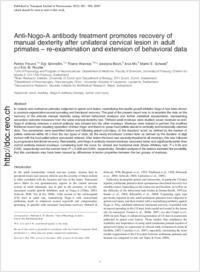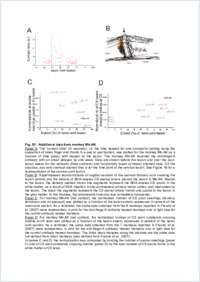Anti-Nogo-A antibody treatment promotes recovery of manual dexterity after unilateral cervical lesion in adult primates – re-examination and extension of behavioral data
- Freund, Patrick Unit of Physiology and Program in Neurosciences, Department of Medicine, Faculty of Sciences, University of Fribourg, Switzerland
- Schmidlin, Eric Unit of Physiology and Program in Neurosciences, Department of Medicine, Faculty of Sciences, University of Fribourg, Switzerland
- Wannier, Thierry Unit of Physiology and Program in Neurosciences, Department of Medicine, Faculty of Sciences, University of Fribourg, Switzerland - Brain Research Institute, University of Zürich and Department of Biology, ETH Zurich, Switzerland
- Bloch, Jocelyne Department of Neurosurgery, Neurosurgery Clinic, University Hospital of Lausanne, Switzerland
- Mir, Anis Neuroscience Research, Novartis Institute for BioMedical Research, Basel, Switzerland
- Schwab, Martin E. Brain Research Institute, University of Zürich and Department of Biology, ETH Zurich, Switzerland
- Rouiller, Eric M. Unit of Physiology and Program in Neurosciences, Department of Medicine, Faculty of Sciences, University of Fribourg, Switzerland
-
02.03.2009
Published in:
- European Journal of Neuroscience. - 2009, vol. 29, no. 5, p. 983 - 996
English
In rodents and nonhuman primates subjected to spinal cord lesion, neutralizing the neurite growth inhibitor Nogo-A has been shown to promote regenerative axonal sprouting and functional recovery. The goal of the present report was to re-examine the data on the recovery of the primate manual dexterity using refined behavioral analyses and further statistical assessments, representing secondary outcome measures from the same manual dexterity test. Thirteen adult monkeys were studied; seven received an anti-Nogo-A antibody whereas a control antibody was infused into the other monkeys. Monkeys were trained to perform the modified Brinkman board task requiring opposition of index finger and thumb to grasp food pellets placed in vertically and horizontally oriented slots. Two parameters were quantified before and following spinal cord injury: (i) the standard 'score' as defined by the number of pellets retrieved within 30 s from the two types of slots; (ii) the newly introduced 'contact time' as defined by the duration of digit contact with the food pellet before successful retrieval. After lesion the hand was severely impaired in all monkeys; this was followed by progressive functional recovery. Remarkably, anti-Nogo-A antibody-treated monkeys recovered faster and significantly better than control antibody-treated monkeys, considering both the score for vertical and horizontal slots (Mann–Whitney test: P = 0.05 and 0.035, respectively) and the contact time (P = 0.008 and 0.005, respectively). Detailed analysis of the lesions excluded the possibility that this conclusion may have been caused by differences in lesion properties between the two groups of monkeys.
- Faculty
- Faculté des sciences et de médecine
- Department
- Département de Médecine
- Language
-
- English
- Classification
- Biological sciences
- License
-
License undefined
- Identifiers
-
- RERO DOC 11723
- DOI 10.1111/j.1460-9568.2009.06642.x
- Persistent URL
- https://folia.unifr.ch/unifr/documents/301121
Other files
Statistics
Document views: 115
File downloads:
- pdf: 229
- Supplementary material: 148

